Peeling is rightfully considered an integral element of complete skin care.
After all, this procedure helps to get rid of small wrinkles in a short time.
Let's figure out what this procedure is, how and how many times retinoic peeling can be done, and whether it is possible to use yellow cleansing when planning a pregnancy.
general information
Retinoic peeling can be called one of the most popular chemical peels due to its high efficiency and low trauma; the results of the procedure are comparable to the effects of expensive injection techniques. Many people are interested in whether it is possible to use retinol at home?
Let's look at the pros and cons of peeling, and what results can be achieved with it.
Retinol cleansing - what is it?
Retinoic peels are sometimes called yellow peels due to their ability to stain the skin. The procedure is aimed at exfoliating dead skin cells.
After peeling, the skin takes on a “renewed” appearance, as young cells appear on the surface, undamaged by the negative effects of the environment.
Retinoic peeling can be classified as superficial-medium peeling; exfoliation affects not only the stratum corneum, but also part of the epidermis and the capillaries that supply it with blood.
The active substance used during the procedure stimulates cells to divide, helping to restore skin density. In addition, retinol counteracts the influence of enzymes that destroy elastin and collagen molecules.
Compound
The very name of the procedure suggests that it is based on the use of retinoic acid, that is, an artificial analogue of vitamin A.
In addition, auxiliary acids are used in peeling:
In the complex, the acids have a pronounced rejuvenating effect:
- exfoliate the skin, stimulating the launch of regenerative processes;
- protect cells from the adverse effects of free radicals;
- restore the density and elasticity of the epidermis.
Advantages and disadvantages
It is the numerous benefits that make yellow peeling with retinoic acid such a popular procedure:
- high efficiency, superior to the achievements of softer peelings;
- painlessness;
- fast recovery period;
- absence of unpleasant complications;
- the ability to perform the procedure in the summer without the risk of skin damage.
The disadvantage is that after exposure to retinol, the skin acquires a yellow tint, which, coupled with severe peeling, does not allow one to lead a normal lifestyle.
In addition, a high concentration of retinol has an ambiguous effect on the human body, so the procedure has many contraindications.
Indications and contraindications for retinoic resurfacing
Yellow peeling is most often used to rejuvenate the face, neck, décolleté and hands. The procedure is recommended for mature ladies, but it is not contraindicated at a young age – with excessive formation of freckles or keratosis.
Good results can be obtained in the following cases:
- facial wrinkles;
- excessive pigmentation;
- photoaging;
- keratosis;
- acne marks or scars;
- blackheads
The procedure is strictly contraindicated for pregnant and lactating women, as well as for those planning a pregnancy in the next year - this is due to the teratogenic effect of retinol on the fetus.
Those who are prone to allergies should also be careful.
Preparation and stages of the procedure
To achieve a noticeable result, a fairly long preparatory period is required - from two to four weeks. First of all, it depends on the skin type you have. For example, the Asian type has increased sensitivity to the drug, and in this case long-term preparation is simply necessary.
A doctor will help you assess the condition of your skin and determine whether it belongs to one type or another during a preliminary examination.
The specialist prescribes home use of creams and masks with low concentrations of vitamin A to soften the skin and prepare it for peeling.
In addition, the doctor must ask what medications you are taking and whether you are planning to conceive a child in the near future.
If it turns out that the patient suffers from herpes, then to prevent rashes it will be necessary to take an antiviral drug even before the procedure itself.
During peeling, the specialist carefully removes makeup from the face and applies a mixture of salicylic and glycolic acid, which help quickly exfoliate dead skin cells. Then retinoic acid is applied - even such a sensitive area as the area around the eyes is covered with the composition.
Further, depending on the concentration of the mixture, the active substance is either washed off after twenty minutes or remains on the face for several hours. After removing the acid, the skin must be moisturized with a product prescribed by a specialist.
Darsonvalization of the face: how to do it and how many procedures are needed for a good result, you can read here.
How many myostimulation procedures are needed and how this technique works for weight loss and eliminating the “orange peel”, read here.
Restoration and care of facial skin after
Before the procedure, be sure to ask your doctor how to care for your face after yellow peeling. For several days after peeling, the epidermis intensively peels off, disappearing into transparent films. At this time, slight itching and discomfort are possible.
The skin may differ in shade in those places where the old layer has not yet come off. You should not speed up the process on your own; let the keratinized scales come off gradually. In the post-peeling period after yellow peeling, it is extremely important to use care products recommended by a specialist.
Therefore, the first weeks after the procedure, the use of sunscreen is simply necessary. It is also advisable to change your regular foundation to one that can withstand ultraviolet radiation.
It is not recommended to use other abrasive procedures until the end of the course; washing is allowed only with products for sensitive skin. During the procedure, it is not advisable to resort to hair coloring or perm, and you should not use cosmetics containing vitamin A or its analogues.
Look at the photo to see how the skin peeling stage goes after yellow peeling:
Effect
Even at the stage of peeling, the difference between aging and young skin is clearly noticeable:
- healthy color is restored;
- wrinkles are smoothed out;
- deep folds become less pronounced;
- Freckles and age spots disappear;
- acne spots or scars become less noticeable;
- dryness and flaking are eliminated.
To better understand what results chemical yellow facial peeling gives, you should read the reviews of those who have tried the method (they are presented at the end of the article) and look at the before and after photos:
Possible complications and consequences
After peeling, many people experience a feeling of tightness and dryness of the skin; cosmetic products prescribed by a doctor will help cope with these problems.
There may be slight swelling or redness - these phenomena are temporary and will go away in a few days. Most often, complications arise when yellow peeling is performed at home. Incorrectly calculated concentration of the active substance, lack of a proper preparatory period - all this can lead to burns, inflammation and severe itching.
It is possible that the body may have a negative reaction to the combination of retinol and the medication you are taking. To minimize the risk of possible complications, entrust the delicate procedure to a qualified specialist.
Duration of the course and prices in salons
Many people are interested in the question: how often can retinoic peeling be done and how expensive will yellow peeling be? Let's figure it out together.
The required course usually includes from 3 to 5 procedures, with an average interval of two weeks. If peeling is intended more for the prevention of aging, then you can get by with one procedure.
The results last for at least five months; the course can be repeated only after six months. The average price for one retinoic peeling procedure ranges from 3 to 5 thousand.
But when calculating the full cost of the yellow cleansing course, do not forget to take into account the cost of care products during the recovery period - they usually cost from 5 to 10 thousand rubles.
In pursuit of beauty, women sometimes decide to make the most unimaginable sacrifices. If you are not afraid of the prospect of peeling skin and the inability to leave the house for several days, yellow peeling is suitable for you. And the reward for temporary inconvenience will be youthful, rosy skin and a feeling of irresistibility.
How often you can do cavitation and why this technique is needed, you will find out here.
The effect of Darsonval on hair is undeniable, you can find out how this happens by clicking here.
Customers' opinions
“I took a retinol peeling course about a year ago. My face, of course, itched a lot, but moisturizing creams helped. The result is excellent - the freckles are gone, the complexion is perfectly even. The wrinkles around the eyes and above the upper lip have become almost invisible! It’s good that I was on maternity leave at the time; I could calmly take care of myself and not frighten those around me (except my husband) with the peeling yellow film.”
“My friend had a procedure done at the salon. She herself is happy, but if I evaluate the result from the outside, I didn’t notice any special changes.
The complexion, of course, became smoother, but the wrinkles remained. “In my opinion, it’s better to spend that kind of money for more effective procedures.”
Ella, 29 years old:
“I used to often visit solariums. As a result, many pigment spots appeared on the cheeks and nose. Homemade scrubs did little to help solve the problem. I decided to resort to peeling, especially since my favorite salon was just holding a promotion. The process is, of course, long, but the result is simply excellent! My complexion is perfectly even, I’ve practically stopped using foundation.”
Marina, 31 years old:
“My husband gave me a certificate for the services of a cosmetologist for my birthday. I thought about it and decided to try retinol peeling. I made my household laugh a lot with my yellow face, but I liked the result. It feels like I’ve lost five years.”
And in conclusion, we suggest watching a video of how the retinoic (yellow) peeling procedure goes:
If you want to look younger and fresher, then you should try a retinoic peeling procedure. This procedure is quite effective and will help get your skin in order. It is used for both the face and neck, décolleté and hands. Retinoic peels are also called yellow peels due to their characteristic color.
What is retinoic peeling
Retinoic peel or yellow peel is a dry cleansing performed with retinoic acid. This procedure effectively rejuvenates the skin and fights unwanted pigmentation on it.

After the procedure, skin cells more actively produce collagen, and oxidative processes slow down, which prevents skin aging.
Types of retinoic peeling
Retinoic peels are divided into three main types:
- Surface. With this type of retinoic peeling, the acid penetrates only into the upper layers of the skin.
- Average. It affects the upper layer of the epidermis and penetrates to the capillaries. This is the type that is used most often.
- Deep. This peeling reaches the reticular part of the dermis. It will not be possible to do it at home.
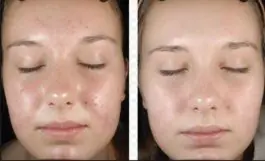
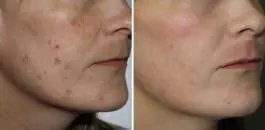
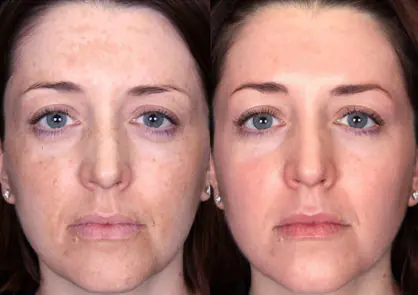
All these types can be divided into two more types:
- One day. The process takes place throughout the day. Apply the mask in the morning and wash it off only after 12 hours.
- Two days. Over the course of two days, apply a retinoic mask to the skin several times. Before applying the next mask, the previous one is carefully removed.
Indications for use
Retinoic peeling can only be prescribed by a dermatologist. Indications for its use may be as follows:


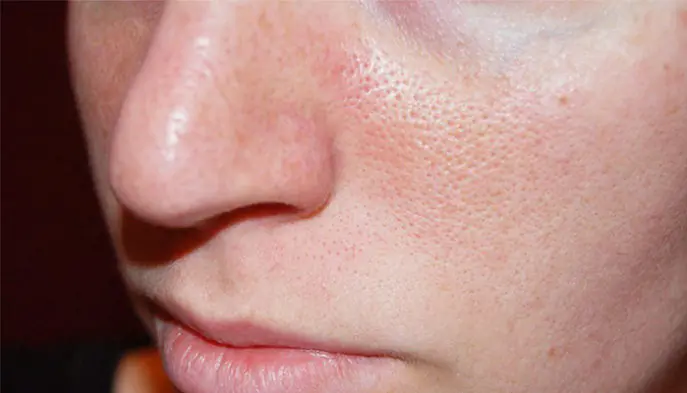
- Violation of skin moisture;
- insufficient elasticity and firmness of the skin;
- acne;
- the presence of facial wrinkles;
- the presence of unwanted pigment spots;
- insufficient collagen production;
- need for skin whitening;
- excessive pore expansion;
- hyperkeratosis;
Contraindications and possible complications
Any procedure has its contraindications, especially chemical ones.
Contraindications:
- Tendency to allergic reactions;
- herpes in acute form;
- presence of warts;
- dermatitis, eczema;
- photosensitivity;
- recent tanning;
- liver diseases;
- viral infections;
- pregnancy or planning one in the near future;
- breast-feeding.

People who decide to undergo the procedure for the first time are always concerned about the possible consequences of such peeling. But complications should not be confused with the body’s normal reaction to such a procedure.
Short-term symptoms after the procedure, which are normal:
- Mild redness and itching. Redness and itching can last from 2 hours to 3 days and goes away on its own.
- Skin tightness and dryness. The first days after peeling, the skin looks dry and tight, this is because the top part of the skin has been removed. These symptoms disappear within a few days.
- Mild swelling. This is the skin's reaction to an external irritant. After peeling, the permeability of the capillaries increases, the liquid, leaving, accumulates in the tissues, forming edema. Swelling is more common in areas with thinner skin, such as the area around the eyes and neck.
- Peeling. This symptom goes away within 3-7 days after peeling. When peeling, the main thing is not to touch the skin flakes; they should come off on their own.
- Skin sensitivity. Skin areas after retinoic peeling become more sensitive to external irritants. Most often this symptom goes away after 1-2 weeks.
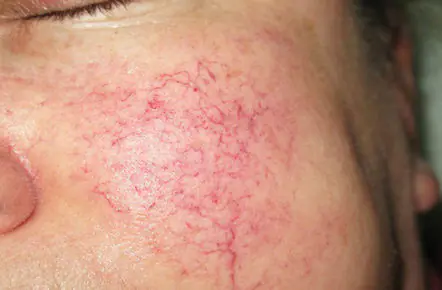
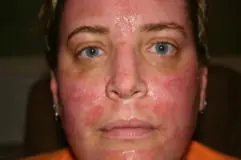
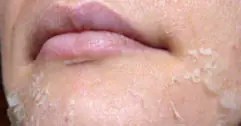
Possible complications:
- Allergic reactions;
- persistent erythema (redness);
- increased acne;
- exacerbation of infectious diseases;
- the appearance of a marbled tint on the skin;
- the appearance of a demarcation line (a clear boundary between the treated area and the untouched one);
- formation of keloid scars.
Important! If one or more signs of complications appear, you should immediately consult a doctor.
How it affects the skin and what effect can be achieved
Changes for the better can be noticed even at the stage of skin restoration. Small wrinkles are smoothed out, and deep ones are less noticeable.


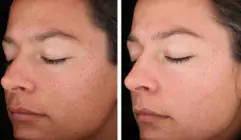
The complexion is restored, it becomes more even, naturally lighter, all age spots disappear, including freckles.
Retinoic peeling eliminates small acne scars or makes more pronounced scars less noticeable. The skin looks hydrated and rested.
All these changes occur due to stimulation of skin cells by retinoic acid. The skin begins to more actively produce collagen and elastane. The amount of lipids increases, and oxidative and reduction processes in the skin intensify.
At what age can you do it?
The age group for retinoic peeling is 35-50 years. But still, one should take into account not only the client’s age, but also the indications for using this procedure. If there are serious problems with the skin, then this peeling can be performed at an earlier age. But you should first consult with a dermatologist.
How often can you peel?
The frequency of peeling depends on what retinol is used for it. If you use natural retinol, you will not have to endure a recovery period. It has a more gentle effect on the skin, so it can be used quite often. Experts recommend its use 2 times every 10-14 days.
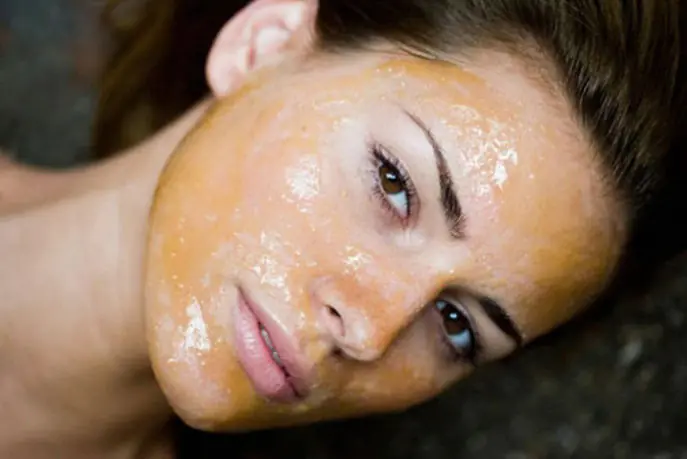
When using synthetic retinol, the skin recovers in 2-3 days. It is not recommended to carry it out more often than 2-3 times over six months.
Preparation
Preparation is a must before a retinoic chemical peel. Its duration can vary from 2 to 4 weeks. Preparation time depends on skin type. For example, the Asian type is quite sensitive to retinol; owners of this skin type are more difficult to tolerate the procedure, so preparing such skin takes longer and time.
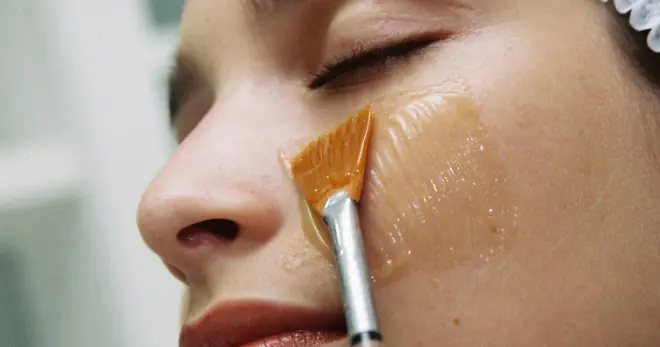
In order to determine your skin type and the exact time of preparation, a preliminary consultation with a doctor is necessary. He will prescribe creams and masks with vitamin A in low concentrations. They are used at home to soften the skin and prepare it for the procedure.
If a patient suffers from herpes, then for preventive purposes the doctor prescribes antiviral drugs to avoid possible rashes.
How is the procedure done in salons?
Immediately before the procedure, the specialist carefully removes cosmetics and cleanses the skin. Then she applies salicylic and glycolic acid to these areas. These acids promote rapid exfoliation of the keratinized part of the cells. After this, retinoic acid is applied to the skin. It is applied even to the most sensitive and thin areas of the skin, such as the area around the eyes, right up to the eyelashes. If the composition contains whitening components, then the mask is not applied to the eyelids.
The mask hardens after 10-25 minutes. Further actions depend on the concentration of the applied mixture. If it is more concentrated, it is removed after 20 minutes, and if it is less concentrated, then after a few hours. After removing retinol, the skin is moisturized with special products. You can wash it off only after 7-12 hours.
Retinoic peeling at home
Retinoic peeling is considered a salon procedure, but today in pharmacies or specialized stores you can purchase special preparations for carrying out this procedure at home.
Along with the chosen product, you should also purchase glycolic acid; it will be needed to prepare the skin.
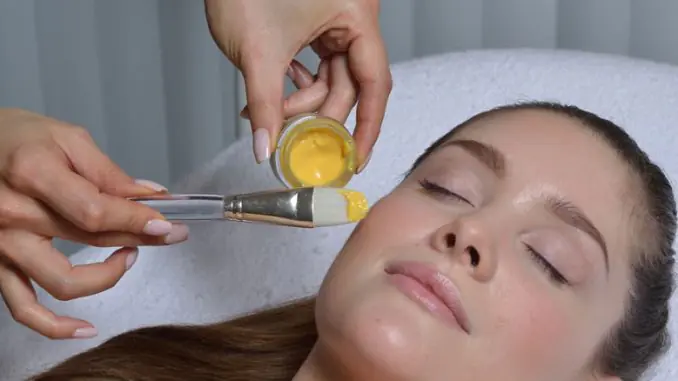
So, the skin is cleansed of decorative cosmetics and possible impurities. Glycolic acid is then applied to it. After it is completely absorbed, a peeling preparation is applied to the skin.
After 45 minutes, the skin is treated with a neutralizing mixture. In order to prepare it, you need to mix equal proportions of water and soda. Apply the mixture to the skin. A slight burning sensation will appear, it should go away after 2-3 minutes. After 6-7 hours, the peeling is removed from the face with a soft towel.
After the procedure, the skin will have a pink tint and will feel slightly tighter. To quickly cope with the consequences of peeling, you should use nourishing and moisturizing creams.
Important! If you do not know which product to choose and are not sure that you can carry out the procedure correctly, you should not take risks, contact a specialist.
Peeling products
There are many retinol-based peels on the market today that are successfully used to rejuvenate the skin.
Cimel
This is an Italian peeling product with a depigmenting effect. Its effect lasts for 4 months after the procedure. The product is indicated for patients with sensitive skin, since the active ingredient in the drug is not retinoic acid, but retinol. It also contains kojic acid, which helps whiten and remove age spots on the skin.
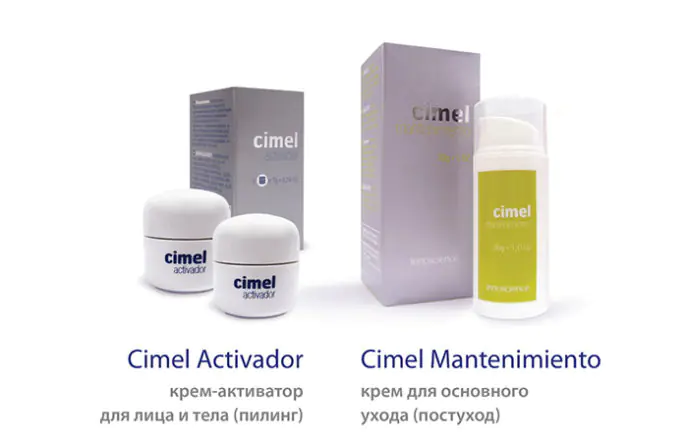
Also contains emblica extract, salicylic acid and phytonadione.
We'll tell you what retinoic peeling is, what makes it unique, why it's called yellow, and why those who are under eighteen love it.
- What is retinoic peeling
- Types of retinoic peeling for the face
- How is peeling done?
- How to care for your skin after a retinoic peel
- Precautionary measures
- Tips and reviews from cosmetologists
What is retinoic peeling
Like any peeling, retinoic peeling is aimed at renewing the skin and improving the appearance of the skin. But it has a number of features that fundamentally distinguish it from its “colleagues”, be it acid, mechanical or hardware versions of peeling. What is its unusualness and why is it called “peeling from the inside”?
Composition and mechanism of action
The main component is retinoic acid. It stimulates the growth and proliferation of keratinocytes, accelerates cellular renewal. It also turns the product yellow. To make it easier to understand how retinoids work with skin cells, let's compare them with their main competitors - fruit acids, for example, glycolic acid. Its goal is to damage the stratum corneum of the skin, resulting in the exfoliation of old cells and their replacement with new ones. Retinoids act differently: they do not destroy anything, moreover, they do not work directly at all either with the cells of the stratum corneum or with intercellular structures.
Retinoic peel is a yellow mask © Getty Images
The target of retinoids is not the surface of the epidermis, but the deeper basal layer in which cells originate. Being small lipophilic molecules, retinoids easily reach their destination and significantly accelerate the division of keratinocytes, or, more simply, the formation of new cells. Young keratinocytes en masse begin to move upward, to the surface of the skin, and literally push out the overlying layers. Hence the effect of exfoliation and renewal.
Retinoic peeling does not destroy dead structures, but stimulates living ones by contacting cell nuclei through special receptors. Moreover, retinoic acid interacts not only with keratinocytes, but also with fibroblasts and melanocytes, improving the condition of the skin in several indicators, including density, elasticity and uniformity of pigmentation.
In addition to retinoic acid itself, the peeling preparation includes auxiliary components, mainly acids, that can enhance one or another cosmetic effect. For example:
whitening: Fetinic, kojic, azeloic acids;
exfoliation: salicylic acid;
fight against free radicals: vitamin C;
calming and anti-stress effect: allantoin, aloe and chamomile extracts.
Indications for use: who will need it and when?
The abilities of retinoic peeling are multifaceted. In addition to standard indications for peelings, including dullness, increased greasiness, uneven surface, retinoic acid works with age-related skin changes, such as:
thickening of the stratum corneum.
Therefore, the majority of fans of retinoic peeling are women who have crossed the forty-year mark.
Skin with acne (not in the inflammatory stage!) and post-acne phenomena also respond well to the effects of retinoids.
Efficiency
Like any peeling, retinoic peeling is done in a course. Although the result in the form of fresh, renewed, radiant, smooth skin can be noticed after the first session. The final effect depends on the number of procedures, the concentration of the chemical agent, and the peeling application regimen. As a result, you can achieve:
smoothing superficial wrinkles and reducing deep ones;
lightening or complete disappearance of age spots;
even out skin texture and tone;
skin tightening and light lifting.
How often can you do it
Types of retinoic peeling for the face
Among cosmetologists and patients, retinoic peeling is known as “Yellow Peel”. The fact is that retinoic acid, like all synthetic analogues of vitamin A, has a bright yellow or orange color - hence the name.
The composition of the peel and the concentration of the main substance vary depending on the specific preparation and manufacturer. Typically, professional Yellow Peel contains 5-10% retinoic acid.
Retinoic acid gives the peel its yellow color © Getty Images
As for the usual classification of peelings (superficial, medium, deep), in the case of retinoids it is very arbitrary. Strictly speaking, retinoic peeling cannot be superficial, since it only works in the deep basal layer of the epidermis. However, with Yellow Peel you can achieve:
medium and medium-deep peeling, renewing all layers of the epidermis.
There is a type of retinoic peeling that works only to tighten the skin turgor and does not cause peeling at all.
How is peeling done?
Preparation
Two weeks before the “yellow peeling”, start using products with acids in your home care. This will help your skin clear the way for retinoids to penetrate into the deeper layers. Usually, special cosmetics are recommended by a cosmetologist. We provide examples of products that meet the requirements of pre-peeling preparation.
Two-stage peeling Visionnaire Crescendo, Lancôme consists of two parts, each of which is designed for two weeks of use. The first phase, just the preparatory phase, includes a low concentration of fruit acids and quinoa husk extract. These substances provide easy exfoliation and accustom the skin to the active action of peeling agents.
Cleansing toner for mature skin against imperfections Blemish & Age Solution, SkinCeuticals Suitable for preparing skin for salon peeling. Contains glycolic, salicylic and capryloyl-salicylic acids for gradual gentle exfoliation.
Night peeling that activates skin radiance, Idéalia, Vichy The formula contains glycolic acid 4% + Hepes 5%, as well as antioxidant blueberry extract. Renews skin and enhances its radiance with fermented black tea extract.
Carrying out the procedure
Before applying the yellow peel, the skin is cleansed and treated with an acid-based lotion to loosen the stratum corneum and facilitate the penetration of retinoic acid.
The peeling itself is a yellow cream mask, which is applied in a thin layer to the entire face (including the skin around the eyes) or to individual areas using rubbing movements. This ends the mandatory stages of the protocol - further options are possible.
Peeling can be tolerated on the face 15-20 minutes, and then rinse with a solution with neutral pH.
Maybe repeated (and repeated) application and rinsing of retinoic peeling during one session.
Another option: leave the mask on for six hours, and then the “yellow-faced” patient goes home and washes off the composition on his own.
The procedure is painless, the maximum discomfort is a slight tingling sensation and a feeling of warmth.
Retinoic peeling solves the problems of aging and young skin © Getty Images
How to care for your skin after a retinoic peel
The rehabilitation period after a procedure with a moderate effect (that is, causing active peeling and renewal of the skin) takes an average of a week.
A feeling of tightness occurs on the 2nd day.
Peeling begins on the 4th day after peeling.
Please note: superficial peeling does not cause discomfort and violent peeling, but the effect of such peeling is less expressive.
During the post-peeling period, you will need cosmetics that meet special requirements. The main one is the complete absence of acids in the composition.
Rules for skin care after peeling
Washing with gel-like products that do not contain aggressive surfactants and oils. Our recommendation - cleaning micellar gel for face and eyelids Rosaliac Gel, La Roche-Posay, , which contains hyaluronic acid in its composition, provides comfort and freshness when washing.
Care including products with the function of protecting and restoring the skin barrier. They need to be applied several times a day for 3–5 days after peeling.
Mandatory sun protection with maximum SPF.
We recommend a restorative soothing agent La Roche-Posay - Cicaplast balm SPF 50 with madecassoside for better skin regeneration and panthenol for a calming effect and restoration of the protective mantle. The solar screen and the prokerad component provide prevention of post-peeling pigmentation.
Precautionary measures
Yellow peeling reduces the skin's immunity, making it susceptible to infections. Often, an exacerbation of herpes occurs as a side effect. Usually cosmetologists prescribe special medications before peeling to prevent this reaction.
Retinoids in high concentrations cause large-plate peeling. Plus, the manifestation of retinoic dermatitis in certain areas of the skin is considered normal, which manifests itself:
Usually these troubles go away on their own after the rehabilitation period.
Tips and reviews from cosmetologists
Medical expert Vichy Elena Eliseeva believes: “Retinoic peeling is a safe and effective procedure.” Below we list its main advantages.
Relatively fast recovery period. Cosmetologists often call it a weekend procedure: if you peel on Friday, your face will return to normal by Monday.
Retinoic peeling is optimal not only for general skin renewal and rejuvenation, but also for targeted correction of hyperpigmentation.
It is carried out in a shorter course, on average 4–5 procedures are enough.
This procedure is contraindicated during pregnancy and lactation; for liver diseases; during the season of active ultraviolet radiation (and in the case of already developed tanning). Contraindications also include damage to the epidermis (due to dermatological diseases or as a result of banal squeezing of pimples).



